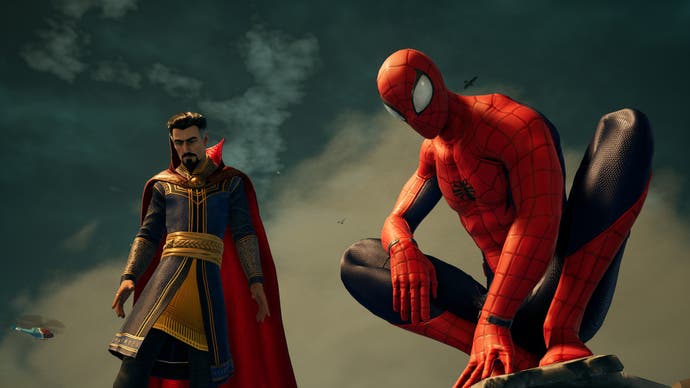Marvel's Midnight Suns review - crush evil, DM the Avengers, and find that perfect bedside table
Love, Doctor Strange.
One night last week I went to a book club with Blade. It was Blade's idea, actually. Captain America and Captain Marvel were there, so we were pretty much knee deep in captains. Blade had arranged the whole thing to spend time with Captain Marvel, but then the other captain overheard and wanted in too, and Blade was too shy to say no. We read The Art of War. It was Blade's pick. We talked about the strategies and wisdom in the text, and someone mentioned how funny it was that Blade's favourite book was written by someone named "Sun". Funny because Blade is a vampire, right? After the book club was done I went foraging for mushrooms with Iron Man. Incredibly, these are not the ramblings of someone who's just banged their head on a shelf.
This is Marvel's Midnight Suns, a game to be excited about because it's also Firaxis' Marvel's Midnight Suns. It's a tactics game in which you pick Marvel heroes and engage in turn-based, card-heavy battles against Hydra and whoever. But it's also a game about cementing the friendships of a bunch of disparate, bickering super-people, who have been brought together by the threat of ancient evil and forced to live outside of time and space in a mysterious abbey. It's XCOM and Fire Emblem. It's a blockbuster about the apocalypse, but it's also the story of a particularly taxing house share.
We will come back to stuff like the book club in a bit. Let's start with the action, with the tactics, the turns and the cards. Running through the middle of the game, as flexible and dependable as a spine, is a series of missions, some story-based, some optional, which see you grabbing three superheroes and heading out to smack baddies around. You choose your mission from a fancy pool-table in the Abbey, gather your gang, and then you're off - New York, the mid-west, other places that I probably shouldn't spoil. This is Firaxis, so there's a bit of theatre to just setting off. In XCOM you had the Skyranger and all of your guys wedged inside waiting for the LZ. In Midnight Suns, you race towards a cliff where Magick, a superhero with portal powers, slices a huge rent in the sky itself, which you obligingly dash into. It's lovely stuff.
Coming from XCOM battles means fighting here took a bit of getting used to for me. The particular staccato rhythm of Firaxis' turn-based combat is alive and well as you make plays and the camera swoops around. It's all there, right down to the Wildean visiting-cards manners-play of status effects being applied at the end of a turn. But you aren't on a grid, you aren't racing to cover, and you have to think about movement in general quite differently. For a while, I felt a little unmoored: here were battles I almost recognised, but there wasn't as much to hang onto.
Over time it all became clear to me. Each turn you can play three cards from your deck, which is shuffled and dealt from a pool made up of each of your mission heroes' personal decks. Cards can be Attacks - hit people with Captain America's shield, if you've brought him along? - or a Skill, like maybe applying counter to your allies or bleed to their attacks. Or they can be Heroic. Heroism is a bit like mana, but it isn't built up automatically. You gain it by playing Attack and Skill cards, which will each have a Heroism payment of some amount, that inevitably plays into your decisions. Once you have a stack of Heroism, you can cash it in on a Heroic card, which will be a really powerful move, like Captain Marvel's photon beam trick, in which she turns into a radioactive hairdryer with a very narrow focus and toasts anyone in her path. Heroic cards use Heroism, then, which means you're always thinking about tempo and resources in a battle, the play of cheap Heroism-building cards against expensive Heroism-spending cards. But Heroism can also be spent on other stuff.

It can be spent on environmental attacks, like picking up a stack of the Daily Bugle and whacking a Hydra soldier with it, or booting a sofa across a room and taking out a bunch of baddies in one go. Environmental attacks live outside of the three card plays you can make each turn. If you have the Heroism to pay for them, you can keep going until you've run out of props to hit people with. They also pull you back more into the world, and make you think about your placement on the battlefield, and particularly your enemies' placement. Can you get a bunch of them to gather around a barrel of oil? Can you get a couple of them within range of a rock you might chuck?
Alongside card plays and environmental attacks, you can also move one character once per turn, which is great for battles that have secondary layers going on, like bombardment from above, telegraphed by markers on the ground, or a grenade that's going to go off in two cards' time. You can also redraw two cards per turn, or use battlefield items, which are very similar to special items in XCOM. Any of these things might turn the tide of a battle.



And they are just the beginning of the depths here. Alongside varying mission objectives and different kinds of environmental tricks and traps, there's the enemy types you're up against - I hate the guys who split in two, or the guys who share a pool of HP they redistribute when injured. Some have no health at all and succumb to a single hit, great for boosting heroism. Some will be bosses who are either there because the story dictates it or are crashing a regular mission to make things harder. What gadflies!
Then there are your heroes, who each have their own focuses. I loved taking Captain Marvel into battle, because she was all about laying on beat-downs, with a bunch of cards that allowed her to target problem enemies - as the enemy types suggest, target prioritisation is the central concern in a lot of battles - and generally chuck people around. But then there are support characters like Doctor Strange and characters like Spider-Man who can spread the damage around a bit. The character you play as - you must take them into battle as story missions and you control them around the abbey - is the Hunter. They're as adaptable as the sliders and whatnot which control what they look like. They're a new character, I gather, created just for this game, and you have scope to make them play the way you want them to. Regardless of who you take out for a mission with them, each hero has a growing stack of cards - we'll get to this - that makes choosing just eight for a load-out the best kind of strategy game torture.

The cards! I am constantly surprised when playing that Midnight Suns is actually a serious card game and not just a game that uses cards as a way of handling attacks and spells from a UI point of view. Alongside attack cards and buffs, there are cards that affect other cards - granting Heroism while drawing a few more cards into your hand, say, or giving you a powerful move but destroying a random card. Synergies are to be found all over the place, even before you get to cards that allow you to team heroes up for really special moves. And the smallprint is always worth reading. Look at the damage, sure, but does the card include knockback, which basically turns the battlefield into a pool table? Does it have quickness, which means that if you kill someone with the attack you get the card play - but not the card itself - back? Even this is just the start of the complexities.
Throw in those special mission types - actually even the procedurally generated missions are pretty entertaining - and Midnight Suns is a proper bit of a delight on the battlefield. Last night, for example, I had an absolute peach of a mission. Rather than kill everybody or collect a doodad, I had to just survive against waves of enemies for four turns. But the twists: low level enemies gave me back a card play when killed, while high level enemies gave me new cards. Chaining those two rules meant I racked up incredible kills: seven KOs in a turn, five KOs from one hero (probably Ghost Rider, that one, who has a special that basically involves running people over). It was tactical, but it also made me feel like I was dealing with a handful of dinky little gods out there. It sold the superhero fantasy - and it did it all with rules.



There’s much to say about this, I imagine. How superheroes are basically collections of rules already, and how great game designers like the team at Firaxis can reveal that Marvel's creators were pretty great game designers too. But we have to move on. The battlefield is the focus of Midnight Suns, sure, but it's not the only thing in the game.
Outside of battles, there's the abbey, a lovely 3D video game hub filled with neat details, from the little ladders on the shelves in the library to the floating candles down in the forge. Like the HQ from XCOM, the abbey is basically a menu rendered in geometry, but, like the HQ in XCOM, it's also so much more.
It can be overwhelming in fact, but I will reduce it all brutally to say: things that happen in the abbey affect the heroes and powers you can take onto the battlefield. They fight out on the streets of New York and beyond, but then they come home to the abbey where the game moves from one day to the next - even dipping into people's dreams at times - as your heroes get along, form bonds, become friends and fall out.
On the most basic level, it's about making friends. The stronger your bond with another hero, the more special moves you might be able to play on the battlefield. Playing as Hunter, and working out what to do with your downtime each day, you make friends by complimenting heroes and spending the evening with one in a hangout - maybe playing pool, maybe looking for mushrooms in the grounds. I am not here to judge.



You chat, and the answers you choose allow you to direct your particular Hunter down light or dark paths, each of which - you guessed it - gives them battle options. You can give heroes gifts, or choose to spar with them. It's fun to see the numbers go up, but it's also fun to see these famous faces chatting about stuff. (Marvel's particularly suited to this, too, since its heroes are all so squabble-prone and imperfect. Midnight Suns gets a load of material out of how self-centered Tony Stark is, for example, or how difficult it is to be a super team in the shadow of the Avengers.)
Elsewhere, the abbey, which you move around in third-person, has plenty of XCOM-alike spaces. There's a place to unlock and choose between the cards you win in each battle, a place to level them up, a place to undertake research which leads to new menus to pick through, a place to send people out on background missions that give you cool stuff but take a hero out of action for a while. Again, this stuff goes deep, but it all comes down to investing in people and collecting resources to make your team more powerful - or more nuanced - out on the battlefield.
Except that's not entirely true. That's not all it comes down to. Sure, you can look into every interaction in the abbey and see the rewards in play - the stats shifting, the things you choose and the things you pass up, the fluttering of alliances and your own light/dark balance. Firaxis is great at this stuff, particularly the classic trick of allowing you something cool that comes at the cost of something else that would have been cool too. And yes, strategy games, with their dense bird's nest systems, encourage players to focus purely on the utility of each system and each interaction.

But there's also more than all that. As with Fire Emblem, say, there's more than just utility in play here. Look at the book club: a whole evening chatting with Blade about what he reads. The scattering of friend points you get for that does not make it seem entirely worthwhile, until you realise that attending the book club with Blade was worthwhile in and of itself. Ditto hanging out with Captain Marvel. Ditto spending money to make your bedroom look nicer - to find the right couch and bedside table and move the art on the walls around, to choose a better jumper to wear in the afternoons. Ditto the whole business of rambling through the abbey's grounds, which grants rewards, certainly, but also makes you feel like you're part of a handful of intriguing mysteries that will need time to unravel. (There's a whole XBLA game out in the abbey grounds, I reckon, and it's got nothing to do with turn-based battling and everything to do with storytelling and exploration.)
This is a great tactical and strategic game, in other words, a game in which everything does something useful somewhere else in the stats table. But it's also a great game in general because it is in love with its surface interactions, its friendships and movie nights and sudden blow-ups. It makes this stuff more than superficial due to the love and craft with which it's all handled. That abbey! You go back to the doll's house after each mission to become a better soldier, but also because the doll's house is a lovely, fascinating thing, and because it is uplifting, in some ways, to play with dolls, even digital ones. It gets you out of yourself slightly.
Who left the brie on the counter in the library? Who's using the superhero social network to joke around? At these moments, Midnight Suns reminds me of the distant past when I was in primary school and when I would play at home with my Ghostbusters toys. I sent them out to catch ghosts and defeat demons, of course. But I also spent a weird amount of time on their imagined domestic lives - cooking dinner at the fire station, which in my case was an old bookcase with bits of cardboard taped on, or putting them to bed. My daughter's doll's house, meanwhile, has dominated the living room for so long because of the weird soap opera it generates. Batman married Summer Barbie, then they got divorced, and now Batman works at the post office. Skipper's leg broke off and had to be fixed with a section of plumber's tape, but now she's a mountaineer, over in the 5x5 Kallax. (Cat Noir has spent 18 months in the bathroom by this point - still counting.)
I did not expect to be thinking about this stuff in a game that also encourages me to get the absolute most out of my battlefield resources, in a game that contains a spell which, if used correctly, allows you to rain enemy dogs down from the sky to their thudding detriment. But that's Marvel, I guess, with those flawed heroes whose powers are accompanied by vanities and vulnerabilities. And that's Firaxis, whose teams, when I once visited the studio, worked in little collegiate huddles in a selection of rooms that remind me of the dorms in the abbey, and who know that a good HQ is always more than just a fancy way of accessing a menu.
















